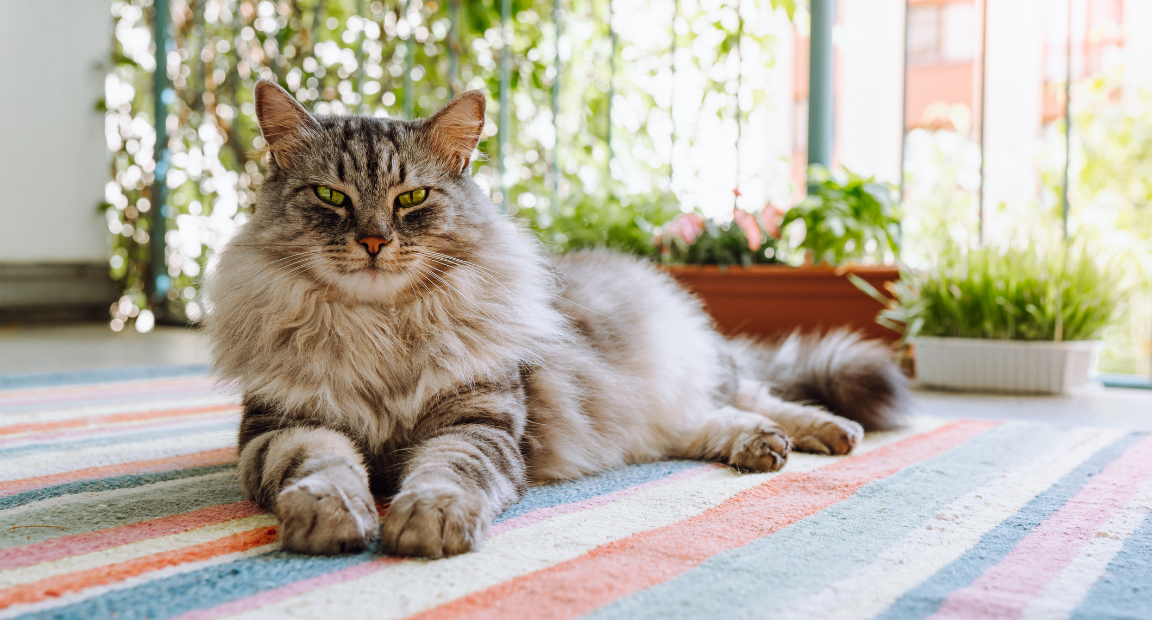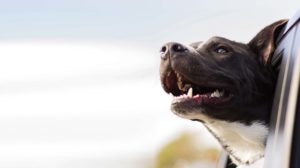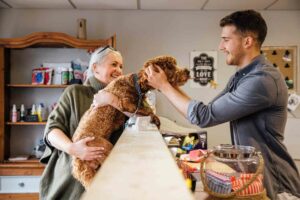Maine Coon | Breed highlights
| Breed: | The Maine Coon is a large purebred cat – the largest in North America. Adult Maine Coon cats can grow up to 40 centimetres. |
| Coat type: | Maine Coon cats are a long-haired cat breed. A purebred Maine Coons has a double coat, a soft, longer top layer and a shorter, denser under layer. |
| Shedding: | Moderate levels of shedding year-round. Maine Coon cats shed more seasonally (Spring and Autumn). |
| Grooming: | Daily brushing is required to keep the top layer of fur tangle free, with more grooming needed during seasonal moults. Bathing and clipping outgrown fur around the paws are also necessary. |
| Activity level: | Maine Coon cats are a playful breed with a naturally well-developed hunting instinct. Games of this nature help provide a reasonable level of activity. |
| Apartment friendly: | Yes, although, due to their size, they may be better suited to a home with more space. |
| Small children: | Yes. The Maine Coon is friendly, although supervision with children is recommended. |
| Other pet friendly: | Yes. Proper introduction and socialisation are required. |
What type of breed is a Maine Coon?
The Maine Coon is a purebred domestic cat which hails from North America. The breed originated in Maine centuries ago – where it is regarded as the official state cat. There is an enduring myth Maine Coons were the result of having interbred with racoons. This tall tale likely gained traction because the breed, particularly tabbies with black and brown striped fur and thick tails, bears some physical similarities to the woodland creature. Since interbreeding between cats and racoons isn’t possible, the ‘coon’ part of the Maine Coon’s name simply refers to this resemblance.
History of the Maine Coon
Maine Coon cats – while one of the oldest Northern American cat breeds – have an unclear history. Their origins are hard to pinpoint – and are primarily the stuff of legends. Some claim the breed landed on American shores after the French Queen Marie Antionette sent them ahead on ships as part of a plan devised for her escape. Others claim the breed came over on Viking ships exploring America along its discovery. It is worth noting there is a physical likeness between the Maine Coon and the Norwegian Forest Cat – which may lend this claim some validity. Regardless of its lineage, cat historians agree the Maine Coon developed its heavy coat in response to freezing Maine winters and exceptional hunting abilities while working as ship’s cats and later as domestic cats on rural American farmlands.
Maine Coon appearance and characteristics
Maine Coons are one of the largest domesticated cat breeds and as adults, they can grow to 40 centimetres in height. Male Maine Coon cats can weigh between five and eight kilograms, with females slightly smaller (3.6 to 5.4 kilograms).
The top coat of the Maine Coon is long and silky and tufts out around the neck and shoulders like a lion’s mane. The tail is also noticeably thicker and fluffier than other cat breeds. Maine Coon cats have an undercoat that may have developed when the breed arrived in Maine as protection against harsh, cold winters. Longer fur also grows around the paws. Maine Coons cat ears are large, with tufts of fur on the tips, which adds to their expressive appearance.
Maine Coon personality and temperament
Despite their imposing appearance, Maine Coon cats are famously friendly and laid-back. While social, they are also reasonably independent and less demanding than other breeds.
Having been bred in rural America, Maine Coons have developed exceptional hunting skills and are particularly adept at catching rodents. The breed likes to play and enjoys toys that use this skill.
Maine Coon cats are suitable for families with children or households with other pets (as long as there have been proper introductions and socialising). The breed is intelligent and has some ‘doglike’ tendencies. Some owners report their Maine Coons to fetch on command, while others have trained their Maine Coon to walk on a leash.
Maine Coon breed traits
As noted, the Maine Coon is a large breed, and while you may see them with predominantly tabby colourings (brown or tiger-striped), they are also available in various hues and cat patterns. These include silver, black and white, ginger, calico, tortoiseshell or smoke.
The Maine Coon has distinctive eye colours: golden, amber or green. Kittens born to the breed have blue eyes; however, these change colour as they age. The eyes are set wide on the face and have a slight slant. Maine Coon cats may also be seen with two different coloured eyes, for example, blue and green, which is known as heterochromia iridis. Heterochromia iridis generally does not cause affected cats to have unwanted symptoms, bit some affected cats may also be deaf.
Maine Coon lifespan
A healthy Maine Coon has a life expectancy of 9to 13 years.
The dos and don’ts of caring for a Maine Coon
Do: Make sure you prioritise grooming. Maine Coons need brushing daily to keep their long topcoat tangle-free. While brushing helps with bonding, it may also allow you during warmer months to check more thoroughly for parasites like ticks, which can potentially go unnoticed in cat breeds like the Maine Coon that have long or dense fur.
Don’t: Don’t allow your Maine Coon to become inactive. This breed is generally social, friendly, and intelligent. They are naturally inclined to hunt and thrive on games that will enable them to display this and use their innate intelligence. Leaving them alone without any activity day in and day out can lead to behavioural problems.
Do: Make sure to feed your Maine Coon a complete, and balanced diet as recommended by your veterinarian. These are large cats, so feeding costs will be slightly higher.
Common Conditions for the Maine Coon
| Conditions | Symptoms can include~ | Highest cost for a single treatment* |
| Gastrointestinal Tract Diseases | · Diarrhoea, vomiting or constipation · Blood or mucous in stool/vomit · Increased frequency/urgency passing stool · Weight loss · Changes in appetite · They may seem more tired than usual | $7,736 |
| Otitis Externa (ear infection) | · Scratching, rubbing or pawing at one or both ears ·Head shaking ·Odour or discharge from the ears ·Ears may be red or warm to the touch | $508 |
| Constipation/Obstipation | ·Straining in the litter tray ·Changes in behaviour ·Vocalising ·Loss of appetite ·Vomiting ·Decrease in activity | $3,332 |
| Limping | ·Avoiding using one or more legs ·Pain or swelling ·Reluctance to participate in normal activities like climbing or jumping | $1,786 |
| Allergic skin disease | ·Excessive grooming or scratching ·Hair loss ·Scabby skin ·Wounds, grazes, ulcers, open sores on the skin ·Ear infections | $974 |
Disclaimer: Reimbursement for these claims would be subject to limits, such as annual benefit limits or sub-limits, benefit percentage, applicable waiting periods and any applicable excess. Cover is subject to the policy terms and conditions. You should consider the relevant Product Disclosure Statement or policy wording available from the relevant provider.
* Please note that the values calculated are based on all claims for that condition and medically related conditions in each calendar year.
Types of pet insurance from PetSure
The different types of pet insurance from PetSure include:
| Accidents | This product provides cover for specified traumatic accidental injuries up to an annual policy limit, which is usually between $8,000 – $15,000. It’s important to know that only defined accidents, as listed in the policy’s Product Disclosure Statement, will be covered (other accidents and illness conditions will not be covered). More information on what is typically covered and not covered in our find a policy page. |
| Basic care | This product provides more limited cover for both accidental injuries and illness conditions, with a stated Benefit Percentage that can range from 60-90%. Treatments and medications for eligible conditions are typically covered subject to the applicable policy limits. More information on what is typically covered and not covered in our find a policy page. |
| Indoor cats | This product provides cover for a list of specified conditions, tailored to the needs of indoor cats (who lead a very different lifestyle to cats that can also venture outdoors). With a stated benefit percentage that’s typically 80%, you can claim up to an annual maximum limit each year, which resets on renewal. More information on what is typically covered and not covered in our find a policy page. |
| Comprehensive / Accident and Illness | This product provides comprehensive cover for both accidental injuries and illness conditions, with a stated Benefit Percentage that will typically range from 70-85%. You can claim up to an annual maximum limit each year, which resets on renewal. sub-limits for certain items may also apply. More information on what is typically covered and not covered in our find a policy page. |
Pet insurance can help by covering a portion of the eligible vet bill if the unexpected happens. Because it is difficult to predict the costs of veterinary care, it can help to have measures in place to help prepare for the unexpected. Check out our partner network and explore our policy tools to find a pet insurance policy. Not all conditions or items are covered by Pet Insurance. Refer to the applicable Product Disclosure Statement for information about coverage and exclusions.
Insurance products are issued by The Hollard Insurance Company Pty Ltd ABN 78 090 584 473, AFSL 241436 (Hollard) and/or PetSure (Australia) Pty Ltd ABN 95 075 949 923, AFSL 420183 (PetSure) (from 8 May 2023 only), administered by PetSure and promoted and distributed through their authorised representatives and distribution partners.
Any advice provided is general only and does not take into account your individual objectives, financial situation or needs. Cover is subject to the policy terms and conditions. Please consider the Product Disclosure Statement (PDS) to ensure this product meets your needs before purchasing, or choosing to continue with the product. PDS and Target Market Determination available on our partners’ websites. Meet our partners at petsure.com.au/partners.
Frequently Asked Questions
According to PetSure data for 2022, the most common health problems affecting Maine Coons were gastrointestinal conditions, including diarrhoea, gastritis, vomiting and gastroenteritis.
Maine Coon cats are affectionate and are not known for being an aggressive cat breed. However, mood or behaviour may change if they become unwell or are injured. A visit to the veterinarian is needed to discuss any noticeable change.
As a large cat breed, the Maine Coon needs space. That said, they can live in an apartment if they have room to play, which is very important for their physical and mental well-being.
Very possibly. Maine Coon cats, like any cat breed, use furniture to keep their claws trimmed. To keep furnishing and carpets intact, invest in a solid, heavy-duty scratching post and introduce this to your Maine Coon from a young age. Watch our ‘How to teach your cat to use a scratching post‘ video to help.
Pet insurance can help by covering a portion of the eligible vet bill if the unexpected happens. Because it is difficult to predict the costs of veterinary care, it can help to have measures in place to help prepare for the unexpected. Check out our partner network and explore our policy tools to find a pet insurance policy.
Not all conditions or items are covered by Pet Insurance. Refer to the applicable Product Disclosure Statement for information about coverage and exclusions.



 Fact checked
Fact checked





